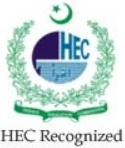
Y-Category

Y-Category
The Kashmir Journal of Science (KrJS) is official publication of University of Azad Jammu & Kashmir. The KrJS is multidisciplinary peer reviewed open access journal. The KrJS welcomes submission of articles (Research & Review) in all scientific fields for the year 2025, which are not under review in any other conference or journal. The Journal does not charge a submission fee or Article Processing fee. For all details About this Journal and Articles Publication please click.